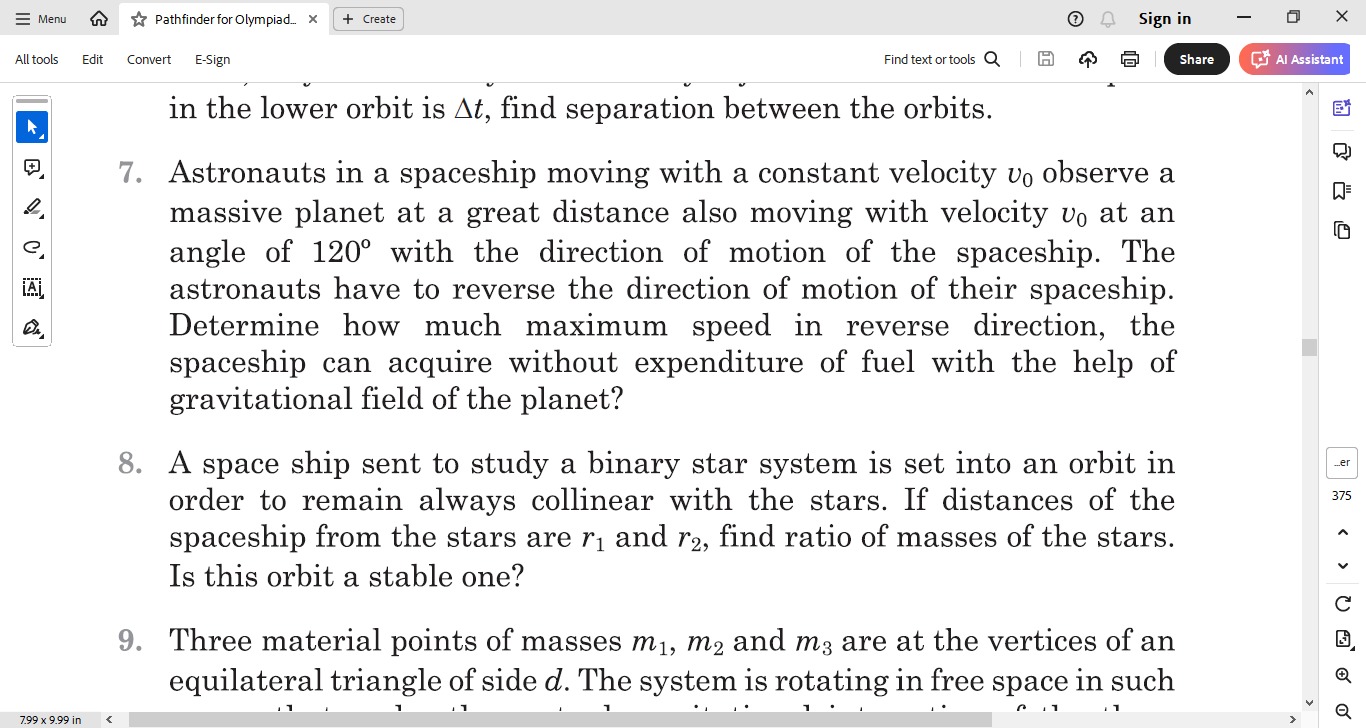Question
Question: Astronauts in a spaceship moving with a constant velocity $v_0$ observe a massive planet at a great ...
Astronauts in a spaceship moving with a constant velocity v0 observe a massive planet at a great distance also moving with velocity v0 at an angle of 120∘ with the direction of motion of the spaceship. The astronauts have to reverse the direction of motion of their spaceship. Determine how much maximum speed in reverse direction, the spaceship can acquire without expenditure of fuel with the help of gravitational field of the planet?

2v_0
Solution
The problem describes a gravitational assist maneuver. The spaceship uses the gravitational field of a massive planet to change its velocity without expending fuel. The key principle is that in the planet's rest frame, the speed of the spaceship remains constant, only its direction changes.
Let vs be the velocity of the spaceship and vp be the velocity of the planet in the ground frame (inertial frame). Initially, the spaceship's velocity is vsinitial=v0. The planet's velocity is vp=v0, at an angle of 120∘ with vsinitial.
Let's set up a coordinate system. Let the initial direction of the spaceship be along the positive x-axis. vsinitial=(v0,0) The planet's velocity vector can be written as: vp=(v0cos120∘,v0sin120∘)=(−v0/2,v03/2)
First, calculate the initial velocity of the spaceship relative to the planet: vrelinitial=vsinitial−vp vrelinitial=(v0−(−v0/2),0−v03/2) vrelinitial=(3v0/2,−v03/2)
The magnitude of this initial relative velocity is: ∣vrelinitial∣=(3v0/2)2+(−v03/2)2=9v02/4+3v02/4=12v02/4=3v02=3v0.
In the planet's rest frame, the spaceship's speed remains unchanged. So, the magnitude of the final relative velocity, ∣vrelfinal∣, is equal to ∣vrelinitial∣. ∣vrelfinal∣=3v0.
The problem asks for the maximum speed the spaceship can acquire in the reverse direction. This means the final velocity of the spaceship in the ground frame, vsfinal, should be in the direction opposite to its initial velocity v0. So, vsfinal=(−Vfinal,0), where Vfinal is the maximum speed we want to find.
Now, express the final relative velocity in terms of vsfinal and vp: vrelfinal=vsfinal−vp vrelfinal=(−Vfinal−(−v0/2),0−v03/2) vrelfinal=(−Vfinal+v0/2,−v03/2)
Equate the square of the magnitudes of the initial and final relative velocities: ∣vrelfinal∣2=∣vrelinitial∣2 (−Vfinal+v0/2)2+(−v03/2)2=(3v0)2 (Vfinal−v0/2)2+3v02/4=3v02 (Vfinal−v0/2)2=3v02−3v02/4 (Vfinal−v0/2)2=9v02/4
Taking the square root of both sides: Vfinal−v0/2=±9v02/4 Vfinal−v0/2=±3v0/2
Two possible cases for Vfinal:
- Vfinal−v0/2=3v0/2 Vfinal=3v0/2+v0/2=4v0/2=2v0
- Vfinal−v0/2=−3v0/2 Vfinal=−3v0/2+v0/2=−2v0/2=−v0
Since Vfinal represents a speed, it must be a positive value. The value Vfinal=−v0 would mean the spaceship is still moving in the original direction (positive x-axis) with speed v0, which is not a reversal of direction with maximum speed. Therefore, the maximum speed the spaceship can acquire in the reverse direction is 2v0.
